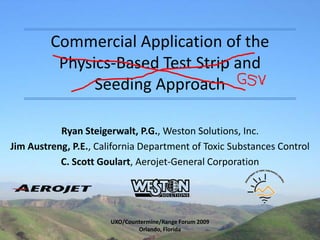Geophysical System Verification - A Commercial Application
- 1. Commercial Application of the Physics-Based Test Strip and Seeding ApproachRyan Steigerwalt, P.G., Weston Solutions, Inc.Jim Austreng, P.E., California Department of Toxic Substances ControlC. Scott Goulart, Aerojet-General CorporationUXO/Countermine/Range Forum 2009Orlando, Florida
- 2. TALKING POINTSIntroduction and Conceptual Site Model Project planning and requirementsImplementation of the Geophysical System Verification (GSV) processPlanning and developmentTest Strip constructionSeeding programOperationsResults
- 3. INTRODUCTIONProject site located in Chino Hills, CAFacility owned by Aerojet-General CorporationPerform MEC detection and removal in areas not previously investigatedUse DGM in all accessible areasPerform mag & dig surveys in all other areas where possibleWork was conducted with DTSC oversightDec 2008 – Feb 2009
- 4. CONCEPTUAL SITE MODELCSM identified anticipated munitions and facility usesExtensive geophysical prove-outs were conducted at the facility in 2004Evaluated detection capabilities of various instruments and techniquesReported the type and quality of data required for subsequent MEC detection and removal activities
- 5. WORK PLANUse results from previous GPODevelop data collection parameters and quality controlPerform a limited GPO and gain concurrenceMobilize remainder of crewCollect data
- 6. PROJECT REQUIREMENTSIn November 2008, wildfire struck the facility and cleared vegetationNeed to perform technically defensible work, quickly, before vegetation returnedMobilize ASAP
- 7. FIELD VARIANCEBegan site setupPreparing to perform limited GPOProject team discussed GSV and potential applicationNo GPO grid constructionStart collecting data immediatelyNo required review cycleJoint QC/QACan continuously monitor performanceDeveloped a brief field variance to document GSV approach- test strip construction and seedingGained regulatory concurrence
- 8. GSV DESIGNTest Strip ConstructionSeed anticipated munitions items at detection depth objectivesPlace seeds at least favorable orientationEstablish multiple Test Strips if necessary to increase efficiencyPerform daily to evaluate equipment functionality
- 9. GSV DESIGNSeeding ProgramUse similar items and burial depths as Test StripsInitially place one seed within each 100-ft x 100-ft grid blockRelax seed frequency to one seed per acre if performance is acceptable
- 10. GSV IMPLEMENTATIONEquipmentEM61-MK2 towed sled4 sensorRTK-GPS NavigationTest StripPerform background and baseline survey prior to production mappingRun Test Strip daily with instrumentationPerform concurrent with standardized QC function testsEvaluate response and monitor results
- 11. SURVEY SUMMARYDigital Geophysical Mapping SummaryCompleted approximately 9 total acresIncludes rough and steep terrainSpanned several weeksAll DGM was performed using a towed array sled
- 12. TEST STRIP 1 RESULTSDay 1 (Baseline)Day 2Day 3Day 4Day 5Day 6
- 13. TEST STRIP 2 RESULTSDay 8Day 9Day 10Day 11
- 14. TEST STRIP SUMMARYDirection of Travel
- 15. SEEDING RESULTS19 total seeds (30mm, 25mm, 20mm)Check response against Test Strip resultsTest Strip Avg ~8 mVResponse (mV)Test Strip Avg ~6 mVTest Strip Avg ~12 mVSeed+xTargetResponse (mV)Response (mV)
- 16. QUALITY ASSURANCERegulatory site visitsIndustry Standard Targets and inert items1-inch by 4-inch pipe nipplesVertical (most favorable) at 11-inchesHorizontal (least favorable) at 7-inches
- 18. BENEFITSMeans to monitor geophysical system performance daily and consistentlyShortened scheduleRe-allocated resources to risk reduction effortsPlanning variance drafted onsiteNo duplicate QC/QABegan production mapping next day
- 19. LESSONS LEARNEDStill need to plan aheadDefine objectivesSeeding programScheduleEnsure Test Strip seeds are isolated from other influenceUse Industry Standard Targets to reduce variabilityReality works



















